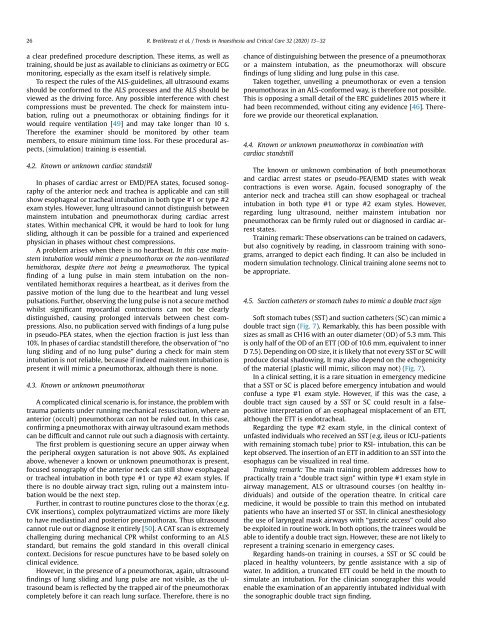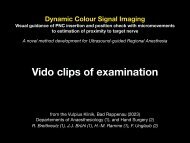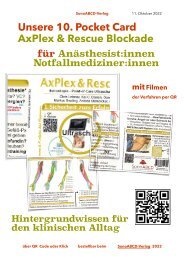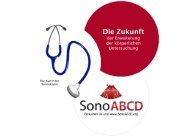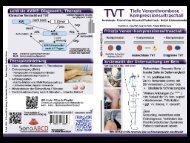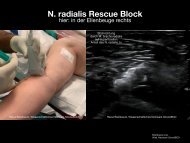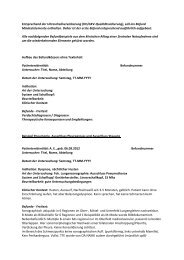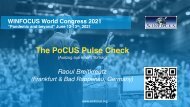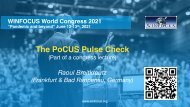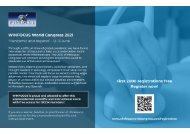Anterior Neck and Airway Ultrasound - a practical overview.
A narrative review. Video clips on our site as well. It is available online at publisher´s site: https://authors.elsevier.com/a/1b66X7si0yR9sx as editor´s pick free of charges.
A narrative review. Video clips on our site as well. It is available online at publisher´s site: https://authors.elsevier.com/a/1b66X7si0yR9sx as editor´s pick free of charges.
You also want an ePaper? Increase the reach of your titles
YUMPU automatically turns print PDFs into web optimized ePapers that Google loves.
26<br />
R. Breitkreutz et al. / Trends in Anaesthesia <strong>and</strong> Critical Care 32 (2020) 13e32<br />
a clear predefined procedure description. These items, as well as<br />
training, should be just as available to clinicians as oximetry or ECG<br />
monitoring, especially as the exam itself is relatively simple.<br />
To respect the rules of the ALS-guidelines, all ultrasound exams<br />
should be conformed to the ALS processes <strong>and</strong> the ALS should be<br />
viewed as the driving force. Any possible interference with chest<br />
compressions must be prevented. The check for mainstem intubation,<br />
ruling out a pneumothorax or obtaining findings for it<br />
would require ventilation [49] <strong>and</strong> may take longer than 10 s.<br />
Therefore the examiner should be monitored by other team<br />
members, to ensure minimum time loss. For these procedural aspects,<br />
(simulation) training is essential.<br />
4.2. Known or unknown cardiac st<strong>and</strong>still<br />
In phases of cardiac arrest or EMD/PEA states, focused sonography<br />
of the anterior neck <strong>and</strong> trachea is applicable <strong>and</strong> can still<br />
show esophageal or tracheal intubation in both type #1 or type #2<br />
exam styles. However, lung ultrasound cannot distinguish between<br />
mainstem intubation <strong>and</strong> pneumothorax during cardiac arrest<br />
states. Within mechanical CPR, it would be hard to look for lung<br />
sliding, although it can be possible for a trained <strong>and</strong> experienced<br />
physician in phases without chest compressions.<br />
A problem arises when there is no heartbeat. In this case mainstem<br />
intubation would mimic a pneumothorax on the non-ventilated<br />
hemithorax, despite there not being a pneumothorax. The typical<br />
finding of a lung pulse in main stem intubation on the nonventilated<br />
hemithorax requires a heartbeat, as it derives from the<br />
passive motion of the lung due to the heartbeat <strong>and</strong> lung vessel<br />
pulsations. Further, observing the lung pulse is not a secure method<br />
whilst significant myocardial contractions can not be clearly<br />
distinguished, causing prolonged intervals between chest compressions.<br />
Also, no publication served with findings of a lung pulse<br />
in pseudo-PEA states, when the ejection fraction is just less than<br />
10%. In phases of cardiac st<strong>and</strong>still therefore, the observation of “no<br />
lung sliding <strong>and</strong> of no lung pulse” during a check for main stem<br />
intubation is not reliable, because if indeed mainstem intubation is<br />
present it will mimic a pneumothorax, although there is none.<br />
4.3. Known or unknown pneumothorax<br />
A complicated clinical scenario is, for instance, the problem with<br />
trauma patients under running mechanical resuscitation, where an<br />
anterior (occult) pneumothorax can not be ruled out. In this case,<br />
confirming a pneumothorax with airway ultrasound exam methods<br />
can be difficult <strong>and</strong> cannot rule out such a diagnosis with certainty.<br />
The first problem is questioning secure an upper airway when<br />
the peripheral oxygen saturation is not above 90%. As explained<br />
above, whenever a known or unknown pneumothorax is present,<br />
focused sonography of the anterior neck can still show esophageal<br />
or tracheal intubation in both type #1 or type #2 exam styles. If<br />
there is no double airway tract sign, ruling out a mainstem intubation<br />
would be the next step.<br />
Further, in contrast to routine punctures close to the thorax (e.g.<br />
CVK insertions), complex polytraumatized victims are more likely<br />
to have mediastinal <strong>and</strong> posterior pneumothorax. Thus ultrasound<br />
cannot rule out or diagnose it entirely [50]. A CAT scan is extremely<br />
challenging during mechanical CPR whilst conforming to an ALS<br />
st<strong>and</strong>ard, but remains the gold st<strong>and</strong>ard in this overall clinical<br />
context. Decisions for rescue punctures have to be based solely on<br />
clinical evidence.<br />
However, in the presence of a pneumothorax, again, ultrasound<br />
findings of lung sliding <strong>and</strong> lung pulse are not visible, as the ultrasound<br />
beam is reflected by the trapped air of the pneumothorax<br />
completely before it can reach lung surface. Therefore, there is no<br />
chance of distinguishing between the presence of a pneumothorax<br />
or a mainstem intubation, as the pneumothorax will obscure<br />
findings of lung sliding <strong>and</strong> lung pulse in this case.<br />
Taken together, unveiling a pneumothorax or even a tension<br />
pneumothorax in an ALS-conformed way, is therefore not possible.<br />
This is opposing a small detail of the ERC guidelines 2015 where it<br />
had been recommended, without citing any evidence [46]. Therefore<br />
we provide our theoretical explanation.<br />
4.4. Known or unknown pneumothorax in combination with<br />
cardiac st<strong>and</strong>still<br />
The known or unknown combination of both pneumothorax<br />
<strong>and</strong> cardiac arrest states or pseudo-PEA/EMD states with weak<br />
contractions is even worse. Again, focused sonography of the<br />
anterior neck <strong>and</strong> trachea still can show esophageal or tracheal<br />
intubation in both type #1 or type #2 exam styles. However,<br />
regarding lung ultrasound, neither mainstem intubation nor<br />
pneumothorax can be firmly ruled out or diagnosed in cardiac arrest<br />
states.<br />
Training remark: These observations can be trained on cadavers,<br />
but also cognitively by reading, in classroom training with sonograms,<br />
arranged to depict each finding. It can also be included in<br />
modern simulation technology. Clinical training alone seems not to<br />
be appropriate.<br />
4.5. Suction catheters or stomach tubes to mimic a double tract sign<br />
Soft stomach tubes (SST) <strong>and</strong> suction catheters (SC) can mimic a<br />
double tract sign (Fig. 7). Remarkably, this has been possible with<br />
sizes as small as CH16 with an outer diameter (OD) of 5.3 mm. This<br />
is only half of the OD of an ETT (OD of 10.6 mm, equivalent to inner<br />
D 7.5). Depending on OD size, it is likely that not every SST or SC will<br />
produce dorsal shadowing. It may also depend on the echogenicity<br />
of the material (plastic will mimic, silicon may not) (Fig. 7).<br />
In a clinical setting, it is a rare situation in emergency medicine<br />
that a SST or SC is placed before emergency intubation <strong>and</strong> would<br />
confuse a type #1 exam style. However, if this was the case, a<br />
double tract sign caused by a SST or SC could result in a falsepositive<br />
interpretation of an esophageal misplacement of an ETT,<br />
although the ETT is endotracheal.<br />
Regarding the type #2 exam style, in the clinical context of<br />
unfasted individuals who received an SST (e.g. ileus or ICU-patients<br />
with remaining stomach tube) prior to RSI- intubation, this can be<br />
kept observed. The insertion of an ETT in addition to an SST into the<br />
esophagus can be visualized in real time.<br />
Training remark: The main training problem addresses how to<br />
<strong>practical</strong>ly train a “double tract sign” within type #1 exam style in<br />
airway management, ALS or ultrasound courses (on healthy individuals)<br />
<strong>and</strong> outside of the operation theatre. In critical care<br />
medicine, it would be possible to train this method on intubated<br />
patients who have an inserted ST or SST. In clinical anesthesiology<br />
the use of laryngeal mask airways with “gastric access” could also<br />
be exploited in routine work. In both options, the trainees would be<br />
able to identify a double tract sign. However, these are not likely to<br />
represent a training scenario in emergency cases.<br />
Regarding h<strong>and</strong>s-on training in courses, a SST or SC could be<br />
placed in healthy volunteers, by gentle assistance with a sip of<br />
water. In addition, a truncated ETT could be held in the mouth to<br />
simulate an intubation. For the clinician sonographer this would<br />
enable the examination of an apparently intubated individual with<br />
the sonographic double tract sign finding.


